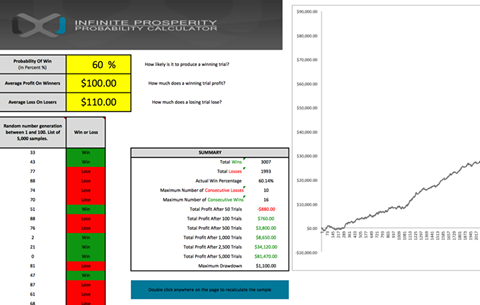The Maths Behind Successful Forex Trading
In Lesson 6 of the Infinite Prosperity Course, you would have downloaded the Infinite Prosperity: Probability Calculator.
For the sake of this short post, let’s set aside any technical, fundamental or mechanical trading elements, and talk purely about probability and numbers.

You can see here that we’ve dialed in the following numbers:
- 60% strike rate
- $100 average win
- $110 average loss
The reason we set the average loss slightly higher than the average win is to more accurately represent the transaction costs on a basic 1:1 reward/risk trading strategy.
For me, the two most significant data points on this particular data set are:
- Maximum Consecutive Losses: 10
- Equity Curve After 289 Trades: $0.00
Let’s break them down a little
1. With this kind of edge (60% strike rate @ 1:1.1 reward/risk) you will certainly make money over time. You can see that in the curve. However, you will also stumble upon scenario’s where you lose 10 times in a row.
If you’re risking 5-10% of your account on every trade… how are you sitting after your 10 consecutive losses? Do the numbers.
Furthermore, if you’re trading multiple balanced sets of currency pairs (Lesson 5), then you may be subject to correlation risk. In other words, your EURUSD long and USDCHF short position are correlated through the USD. This fact can elongate the consecutive loss figure produced by this random number generator. In English: You can, and most likely will, in practice of this particular edge, lose even more than 10 trades in a row at some point!
You must risk manage accordingly if you don’t want to blow your account. Any educator promoting 5-10% account risk per trade is not worth listening to. They simply haven’t done the maths (despite how good their strategy may very well be).
2. If you’re trading a 60% strike rate @ 1:1.1 reward/risk… you could literally be at break even after 289 trades, despite harnessing a profitable edge.
Now, do you think, in all reality, that you’d still be trading a strategy flawlessly if you hadn’t made a profit after 289 trades? It’s very unlikely!
Can you see why most people who try, never actually become professional traders?
Here’s the truth of point 2: I’ve never met anyone who got to 289 (flawlessly executed) trades yet still hadn’t made money. By the time they get to 50-100 trades with zero net performance discrepancy, they usually transcend their initial mechanical strategies and move into a more advanced trading routine. The first 50-100 mechanical trades lay the foundation of their trader’s mindset. The next 50-100 inherently beckons a higher strike rate and/or a higher reward/risk, thus shortening the time it takes for their edge to play out.
These are the numbers! This is not our opinion, preference, style or taste. Sure, we have our own style as well, but trading style must always be developed around the universal laws. Maths and probability do not and will not bend around your trading style or expectations.



Leave a Comment